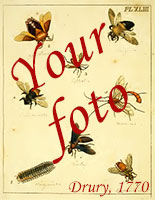Crocisa rufipes Perty, 1833:149,Provincia Piauhiensi. - Dalla Torre, 1896Dalla Torre, C.G. 1896. Catalogus Hymenopterorum hucusque descriptorum systematicus et synonymicus, X. Apidae (Anthophila). Sumptibus Guilelmi Engelmann, 1-643.:324 ( listed as synonym of Melissa azurea (Lepeletier & Serville, 1825)). - As Melissa rufipes: - Smith, 1854Smith, F. 1854. Catalogue of Hymenopterous Insects in the Collection of the British Museum. Part II. Apidae. London. 465 pp, 8 pl. (distribution); Cresson, 1865Cresson, E.T. 1865. On the Hymenoptera of Cuba. Proceedings of the Entomological Society of Philadelphia 4:200 pp. (distribution); Cresson, 1879Cresson, E.T. 1879. Catalogue of North American Apidae. Transactions of the American Entomological Society and Proceedings of the Entomological Section of the Academy of Natural Sciences 7:215-232. (distribution); Friese, 1921Friese, H. 1921. Nachtrag zur Bienenfauna von Costa Rica. Stettiner Entomologische Zeitung 82:74-98.:79 ( listed as synonym of Melissa azurea (Lepeletier & Serville, 1825)). - As Mesoplia rufipes: - Rozen, 1969Rozen, J.G. 1969. The larvae of Anthophoridae (Hymenoptera, Apoidea), Part 3. The Melectini, Ericrocini, and Rhathymini. American Museum Novitates 2382:1-24. (distribution); Snelling & Brooks, 1985Snelling, R.R. & W. Brooks 1985. A review of the genera of cleptoparasitic bees of the tribe Ericrocini (Hymenoptera: Anthophoridae). Contributions in Science, Natural History Museum Los Angeles County 369:1-34.:21 (listed); Snelling, 1994Snelling, R.R. 1994. Collecting on Guana Island. Melissa 7:15. (distribution); Rozen, 2000Rozen, J.G. 2000. Pupal descriptions of some cleptoparasitic bees (Apidae), with a preliminary generic key to pupae of cleptoparasitic bees (Apoidea). American Museum Novitates 3289:1-19. (distribution); Vergara & Ayala, 2002Vergara, C.H. & R. Ayala 2002. Diversity, Phenology and Biogeography of the bees (Hymenoptera: Apoidea) of Zapotitlán de las Salinas, Puebla, Mexico. Journal of the Kansas Entomological Society 75 (1):16-30. (distribution); Ruíz-Cancino & Coronado-Blanco, 2002Ruíz-Cancino, E. & J.M. Coronado-Blanco 2002. Artrópodos terrestres de los estados de Tamaulipas y Nuevo León, México. Serie Publicaciones Cientificas No. 4:1-376. (distribution); Genaro, 2007Genaro, J.A. 2007. Las abejas (Hymenoptera: Apoidea: Anthophila) de la Hispaniola, Antillas. Boletín de la Sociedad Entomológica Aragonesa 40:247-254. (distribution); Perez-Gelabert, 2008Perez-Gelabert, D.E. 2008. Arthropods of Hispaniola (Dominican Republic and Haiti): A checklist and bibliography. Zootaxa 1831:1-530. (distribution); Imperatriz-Fonseca et al., 2011Imperatriz-Fonseca, V.L., I. Alves-dos-Santos, P. Souza Santos-Filho, W. Engels, M. Ramalho, W. Wilms, J.B Vicentin Aguilar, C.A. Pinheiro-Machado, D. Araújo Alves & A. Matos Peixoto Kleinert 2011. Checklist of bees and honey plants from São Paulo State, Brazil. Biota Neotropica 11 (1a):631-655. (distribution); Silvestre et al., 2014Silvestre, R., M.F. Demétrio, B.M. Trad, F. Varussa & O. Lima 2014. Diversity and distribution of Hymenoptera Aculeata in Midwestern Brazilian dry forests. In: Greer, F.E. (Ed.). Dry Forests. 29-80. (distribution); Oliveira Lima & Silvestre, 2017Oliveira Lima, F.V. de & R. Silvestre 2017. Abelhas (Hymenoptera, Apidae sensu lato) do Estado de Mato Grosso do Sul, Brasil. Iheringia Série Zoologia 107 (supl.):1-14. (distribution); Sagot et al., 2018Sagot, P, J. Mérida, R. Ayala & R. Vandame 2018. Situación actual del conocimiento de la fauna de abejas (Apoidea: Anthophila) del estado de Chiapas, México. In: (Ed.). Memorias X Congreso Mesoamericano sobre Abejas Nativas. 191-2011. (distribution); Perez-Gelabert, 2020Perez-Gelabert, D.E. 2020. Checklist, bibliography and quantitative data of the arthropods of Hispaniola. Zootaxa 4749:1-668. (distribution); Nava-Bolaños & Osorio-Olvera, 2022Nava-Bolaños, A. & L. Osorio-Olvera 2022. Estado del arte del conocimiento de biodiversidad de los polinizadores de México. Revista Mexicana de Biodiversidad 93:1-77. (distribution).

